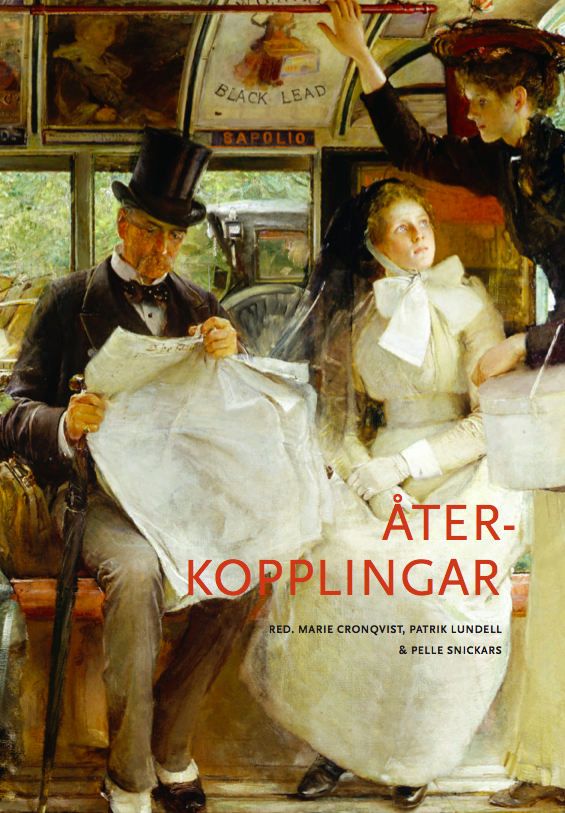Marie Cronqvist, Patrik Lundell, Pelle Snickars (eds.): Återkopplingar (2014) [Swedish]
Filed under book | Tags: · cultural history, media, media archeology, media history, media technology, technology, theory

Återkopplingar [Feedback] is a recent collection on media history and archeology edited by scholars from the universities in Lund and Umeå.
“Det bedrivs alltför lite mediehistorisk forskning i Sverige. Mediehistoria kan – och bör – skrivas på många olika sätt. En ambition inom den kulturhistoriska medieforskning som presenteras i den kommande boken, Återkopplingar, är att genom ett breddat mediebegrepp och historisk sensibilitet uppdatera mediestudiet. Förnyelsen sker inte sällan i skärningspunkten mellan den ofta teknikdeterministiska mediearkeologin och den historiskt lika anspråksfulla som problematiska medialiseringsteorin.
I denna bok presenteras 19 mediehistoriska texter som behandlar medieformer som skrivbord, papper, affischer, kassetter, fisheye linser, radio, telegraf, film, smarta telefoner, litografier, dagstidningar, mikrofilm, begagna de mp3-filer, krigsbyten, biblioteksbyggnader och ölkrus. I boken presenteras en rad samtida perspektiv på förflutna medier – allt i form av en icke-linjär växelverkan mellan nu och då – därav titeln: Återkopplingar.”
Publisher Mediehistorisktarkiv, Lunds universitet, 2014
Mediehistorisk arkiv, 28
Creative Commons BY-NC-ND 3.0 License
ISBN 9789198196122
416 pages
PDF
See also Media archaeology page on Monoskop wiki.
Siegfried Zielinski: Deep Time of the Media: Toward an Archaeology of Hearing and Seeing by Technical Means (2002–) [EN, ES]
Filed under book | Tags: · alchemy, art, cinema, electricity, machine, magic, mathematics, media, media archeology, networks, perception, religion, telegraphy, theatre, time, video, vision

“Siegfried Zielinski argues that the history of the media does not proceed predictably from primitive tools to complex machinery; in Deep Time of the Media, he illuminates turning points of media history—fractures in the predictable—that help us see the new in the old.
Drawing on original source materials, Zielinski explores the technology of devices for hearing and seeing through two thousand years of cultural and technological history. He discovers the contributions of ‘dreamers and modelers’ of media worlds, from the ancient Greek philosopher Empedocles and natural philosophers of the Renaissance and Baroque periods to Russian avant-gardists of the early twentieth century. ‘Media are spaces of action for constructed attempts to connect what is separated,’ Zielinski writes. He describes models and machines that make this connection: including a theater of mirrors in sixteenth-century Naples, an automaton for musical composition created by the seventeenth-century Jesuit Athanasius Kircher, and the eighteenth-century electrical tele-writing machine of Joseph Mazzolari, among others.”
Originally published as Archäologie der Medien: Zur Tiefenzeit des technischen Hörens und Sehens, Rowohlt, Reinbek bei Hamburg, 2002.
Foreword by Timothy Druckrey
Translated by Gloria Custance
Publisher MIT Press, 2006
ISBN 0262240491, 9780262240499
375 pages
Reviews: Simon Werrett (Technology and Culture, 2007), Digital Creativity (2007), Simone Natale (Canadian Journal of Communication, 2012), Stephanie Lam (n.d.).
Deep Time of the Media: Toward an Archaeology of Hearing and Seeing by Technical Means (English, trans. Gloria Custance, 2006, 10 MB, updated on 2020-3-24)
Arqueología de los Medios. Hacia el tiempo profundo de la visión y la audición técnica (Spanish, trans. Alvaro Moreno-Hoffmann, 2011, 9 MB, added 2015-6-1 via Will, updated on 2020-3-24)
Karla Jasso: Arte-tecnología: Arqueología, dialéctica, mediación (2013) [Spanish]
Filed under book | Tags: · art, art history, machine, mechanics, media, media archeology, media theory, mediation, music, negative dialectics, technology

A volume on art, media theory and media archaeology with chapters on Adorno, Kittler, Zielinski, Athanasius Kircher and Alejandro Favián, based on author’s dissertation thesis in art history defended at the Universidad Nacional Autónoma de México (UNAM) in 2012.
Self-published in Ciudad de Mexico, 2013
329 pages
PDF
on Academia.edu (from the author)
ARG

